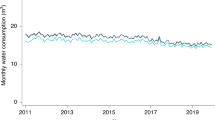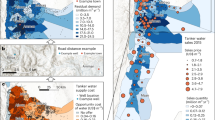Abstract
With increasing water security challenges, water utilities around the world face complex decisions on water supply and demand management. Here we investigate the effects of price and subsidy increases on water conservation in Singapore. Using anonymized monthly billing data on water consumption for 2.2 million residential accounts over 10 years, our difference-in-differences estimates show that the announcement of a two-phased 30% price increase reduces water consumption by 3.7% more for the public housing, relative to the private apartments. The announcement effect is larger than the implementation of price increase. Consumers with lower water usage respond more to the announcement of price hike, while consumers with higher usage respond more to its implementation. An increase in utility subsidy reduces low-income households’ financial burden but does not affect water consumption, possibly due to consumers’ low attentiveness to the subsidy change. The results suggest that the traditional market-based policy instruments, such as price and subsidy, could be combined with attention priming to achieve sustainable outcomes with minimal requirement on technology advancement and institutional innovation.
This is a preview of subscription content, access via your institution
Access options
Subscribe to this journal
Receive 12 digital issues and online access to articles
$99.00 per year
only $8.25 per issue
Buy this article
- Purchase on Springer Link
- Instant access to full article PDF
Prices may be subject to local taxes which are calculated during checkout





Similar content being viewed by others
Data availability
The water consumption data for this study are provided by PUB, Singapore’s national water agency, under non-disclosure agreement for the current study. Upon reasonable request to PUB and with the necessary non-disclosure agreements signed with NUS, it is available onsite at NUS to replicate all the results from the deposited Stata code.
Code availability
Stata code used for data analysis in this study is available at https://github.com/fmsgp/waterprice.
References
Stavins, R. N. in Environmental Degradation and Institutional Responses (eds Mäler, K.-G. & Vincent, J. R.) 355–435 (Elsevier, 2003).
Grafton, R. Q. & Ward, M. B. Prices versus rationing: Marshallian surplus and mandatory water restrictions. Econ. Rec. 84, S57–S65 (2008).
Mansur, E. T. & Olmstead, S. M. The value of scarce water: measuring the inefficiency of municipal regulations. J. Urban Econ. 71, 332–346 (2012).
Grafton, R. Q., Ward, M. B., To, H. & Kompas, T. Determinants of residential water consumption: evidence and analysis from a 10-country household survey. Water Resour. Res. https://doi.org/10.1029/2010wr009685 (2011).
Olmstead, S. M. & Stavins, R. N. Comparing price and nonprice approaches to urban water conservation. Water Resour. Res. https://doi.org/10.1029/2008wr007227 (2009).
Grafton, R. Q., Chu, L. & Wyrwoll, P. The paradox of water pricing: dichotomies, dilemmas, and decisions. Oxford Rev. Econ. Policy 36, 86–107 (2020).
Espey, M., Espey, J. & Shaw, W. D. Price elasticity of residential demand for water: a meta-analysis. Water Resour. Res. 33, 1369–1374 (1997).
Dalhuisen, J. M., Florax, R. J. G. M., de Groot, H. L. F. & Nijkamp, P. Price and income elasticities of residential water demand: a meta-analysis. Land Econ. 79, 292–308 (2003).
Wichman, C. J., Taylor, L. O. & von Haefen, R. H. Conservation policies: who responds to price and who responds to prescription? J. Environ. Econ. Manage. 79, 114–134 (2016).
Gaudin, S. Effect of price information on residential water demand. Appl. Econ. 38, 383–393 (2006).
Jessoe, K. & Rapson, D. Knowledge is (less) power: experimental evidence from residential energy use. Am. Econ. Rev. 104, 1417–1438 (2014).
Ito, K. Do consumers respond to marginal or average price? Evidence from nonlinear electricity pricing. Am. Econ. Rev. 104, 537–563 (2014).
Brent, D. A. & Ward, M. B. Price perceptions in water demand. J. Environ. Econ. Manage. 98, 102266 (2019).
Chetty, R., Looney, A. & Kroft, K. Salience and taxation: theory and evidence. Am. Econ. Rev. 99, 1145–1177 (2009).
Finkelstein, A. E-ZTAX: tax salience and tax rates. Q. J. Econ. 124, 969–1010 (2009).
Sexton, S. Automatic bill payment and salience effects: evidence from electricity consumption. Rev. Econ. Stat. 97, 229–241 (2015).
Gilbert, B. & Graff Zivin, J. Dynamic salience with intermittent billing: evidence from smart electricity meters. J. Econ. Behav. Organ. 107, 176–190 (2014).
Wichman, C. J. Information provision and consumer behavior: a natural experiment in billing frequency. J. Public Econ. 152, 13–33 (2017).
Attari, S. Z., DeKay, M. L., Davidson, C. I. & de Bruin, W. B. Public perceptions of energy consumption and savings. Proc. Natl Acad. Sci. USA 107, 16054–16059 (2010).
Bollinger, B., Leslie, P. & Sorensen, A. Calorie posting in chain restaurants. Am. Econ. J. Econ. Policy 3, 91–128 (2011).
Grubb, M. D. & Osborne, M. Cellular service demand: biased beliefs, learning, and bill shock. Am. Econ. Rev. 105, 234–271 (2015).
Allcott, H. Consumers’ perceptions and misperceptions of energy costs. Am. Econ. Rev. 101, 98–104 (2011).
Renwick, M. E. & Archibald, S. O. Demand side management policies for residential water use: who bears the conservation burden? Land Econ. 74, 343 (1998).
Gomez-Lobo, A. & Contreras, D. Water subsidy policies: a comparison of the Chilean and Colombian schemes. World Bank Econ. Rev. 17, 391–407 (2003).
Borenstein, S. The redistributional impact of nonlinear electricity pricing. Am. Econ. J. Econ. Policy 4, 56–90 (2012).
Fuente, D. et al. Water and sanitation service delivery, pricing, and the poor: an empirical estimate of subsidy incidence in Nairobi, Kenya. Water Resour. Res. 52, 4845–4862 (2016).
Congdon, W. J., Kling, J. R. & Mullainathan, S. Behavioral economics and tax policy. Natl. Tax J. 62, 375–386 (2009).
Epley, N., Mak, D. & Idson, L. C. Bonus of rebate?: the impact of income framing on spending and saving. J. Behav. Decis. Mak. 19, 213–227 (2006).
Agarwal, S. & Qian, W. Consumption and debt response to unanticipated income shocks: evidence from a natural experiment in Singapore. Am. Econ. Rev. 104, 4205–4230 (2014).
Li, S., Linn, J. & Muehlegger, E. Gasoline taxes and consumer behavior. Am. Econ. J. Econ. Policy 6, 302–342 (2014).
Allcott, H. Social norms and energy conservation. J. Public Econ. 95, 1082–1095 (2011).
Ferraro, P. J. & Price, M. K. Using nonpecuniary strategies to influence behavior: evidence from a large-scale field experiment. Rev. Econ. Stat. 95, 64–73 (2013).
Byrne, D. P., Nauze, A. L. & Martin, L. A. Tell me something I don’t already know: informedness and the impact of information programs. Rev. Econ. Stat. 100, 510–527 (2018).
Roth, J. Pretest with caution: event-study estimates after testing for parallel trends. Am. Econ. Rev. Insights 4, 305–322 (2022).
Agarwal, S., Araral, E., Fan, M., Qin, Y. & Zheng, H. Water conservation through plumbing and nudging. Nat. Hum. Behav. 6, 858–867 (2022).
Scarrow, R. Step back from scientific hubris. Nat. Sustain. 4, 1015–1016 (2021).
Acknowledgements
All the authors acknowledge the funding and water consumption data support from the PUB, Singapore’s national water agency. The funder had no role in study design, data analysis, decision to publish or preparation of the manuscript. Research reported in this publication was supported by the Institute for Environment and Sustainability, at the Lee Kuan Yew School of Public Policy, National University of Singapore.
Author information
Authors and Affiliations
Contributions
All authors contributed to the research design, implementation, data analysis and writing.
Corresponding author
Ethics declarations
Competing interests
The authors declare no competing interests.
Peer review
Peer review information
Nature Water thanks R. Quentin Grafton, V. Ratna Reddy and the other, anonymous, reviewer(s) for their contribution to the peer review of this work.
Additional information
Publisher’s note Springer Nature remains neutral with regard to jurisdictional claims in published maps and institutional affiliations.
Supplementary information
Supplementary Information
Supplementary Figs. 1–12 and Tables 1–13.
Source data
Source Data Fig. 1
Statistical source data.
Source Data Fig. 2
Statistical source data.
Source Data Fig. 3
Statistical source data.
Source Data Fig. 4
Statistical source data.
Source Data Fig. 5
Statistical source data.
Rights and permissions
Springer Nature or its licensor (e.g. a society or other partner) holds exclusive rights to this article under a publishing agreement with the author(s) or other rightsholder(s); author self-archiving of the accepted manuscript version of this article is solely governed by the terms of such publishing agreement and applicable law.
About this article
Cite this article
Agarwal, S., Araral, E., Fan, M. et al. The effects of policy announcement, prices and subsidies on water consumption. Nat Water 1, 176–186 (2023). https://doi.org/10.1038/s44221-023-00028-1
Received:
Accepted:
Published:
Issue Date:
DOI: https://doi.org/10.1038/s44221-023-00028-1
This article is cited by
-
An analysis of barriers and perspectives for circular economy in industrial water use in Kazakhstan
Sustainable Water Resources Management (2024)



